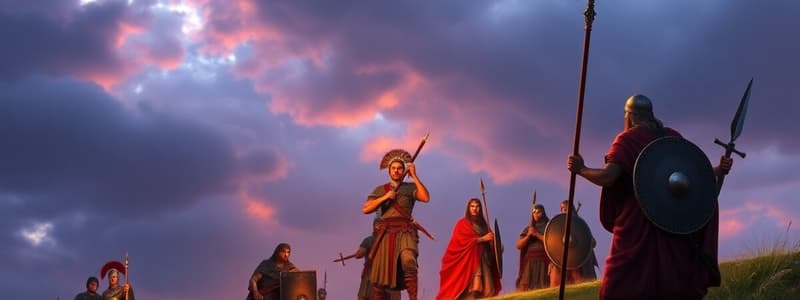Podcast
Questions and Answers
What was the role of druids in ancient Celtic culture?
What was the role of druids in ancient Celtic culture?
- They acted as political leaders.
- They served as high-ranking priests. (correct)
- They were skilled warriors in the tribes.
- They were merchants trading with Romans.
Which famous figure led an uprising against Roman rule in Britain?
Which famous figure led an uprising against Roman rule in Britain?
- Alfred the Great
- Hadrian
- Julius Caesar
- Queen Boudica (correct)
What was a notable feature of Roman towns in Britain?
What was a notable feature of Roman towns in Britain?
- Towns built entirely underground.
- Circular layout with a central castle.
- Synagogue as the main place of worship.
- Grid-patterned streets and a central forum. (correct)
What significant infrastructure did Romans introduce to Britain?
What significant infrastructure did Romans introduce to Britain?
Which group continued to resist invasions after the Roman departure?
Which group continued to resist invasions after the Roman departure?
At what age were children considered adults in Anglo-Saxon England?
At what age were children considered adults in Anglo-Saxon England?
What material were Anglo-Saxon houses primarily made of?
What material were Anglo-Saxon houses primarily made of?
What was a common remedy used for wounds in Anglo-Saxon England?
What was a common remedy used for wounds in Anglo-Saxon England?
What was the primary focus of Pagan beliefs in the Anglo-Saxon period?
What was the primary focus of Pagan beliefs in the Anglo-Saxon period?
Who held the highest position in the Anglo-Saxon social hierarchy?
Who held the highest position in the Anglo-Saxon social hierarchy?
In Anglo-Saxon law, what was ‘wergild’ used to determine?
In Anglo-Saxon law, what was ‘wergild’ used to determine?
What significant change occurred with the spread of Christianity among the Anglo-Saxons?
What significant change occurred with the spread of Christianity among the Anglo-Saxons?
What role did the community play in the Anglo-Saxon justice system?
What role did the community play in the Anglo-Saxon justice system?
What was a common form of trial used in Anglo-Saxon justice if proof of innocence was lacking?
What was a common form of trial used in Anglo-Saxon justice if proof of innocence was lacking?
Which group in the Anglo-Saxon hierarchy had the least freedoms and was often tied to the land?
Which group in the Anglo-Saxon hierarchy had the least freedoms and was often tied to the land?
What were 'hundreds' in Anglo-Saxon England?
What were 'hundreds' in Anglo-Saxon England?
Flashcards
Roman Invasion of Britain
Roman Invasion of Britain
The period when the Romans conquered Britain, lasting from 55 BC to 410 AD.
Queen Boudica
Queen Boudica
A British queen who led a rebellion against Roman rule.
Roman Legacy in Britain
Roman Legacy in Britain
The lasting impact of Roman rule, including infrastructure, towns, and law.
Hadrian's Wall
Hadrian's Wall
Signup and view all the flashcards
Anglo-Saxon England
Anglo-Saxon England
Signup and view all the flashcards
Anglo-Saxon daily life
Anglo-Saxon daily life
Signup and view all the flashcards
Celtic Religion
Celtic Religion
Signup and view all the flashcards
Roman Towns
Roman Towns
Signup and view all the flashcards
Anglo-Saxon Pagan worldview
Anglo-Saxon Pagan worldview
Signup and view all the flashcards
Anglo-Saxon Christian worldview
Anglo-Saxon Christian worldview
Signup and view all the flashcards
Anglo-Saxon social hierarchy
Anglo-Saxon social hierarchy
Signup and view all the flashcards
Wergild
Wergild
Signup and view all the flashcards
Community-driven justice
Community-driven justice
Signup and view all the flashcards
Trial by ordeal
Trial by ordeal
Signup and view all the flashcards
Anglo-Saxon Administrative divisions
Anglo-Saxon Administrative divisions
Signup and view all the flashcards
Crimes and Punishments
Crimes and Punishments
Signup and view all the flashcards
Study Notes
Ancient Britain: From Celtic Druids to Anglo-Saxon England
- Early Inhabitants: Britons practiced an ancient Celtic religion, led by druids, deeply connected to nature.
- Roman Invasion: Roman invasion began in 55 BC under Julius Caesar, lasting until 410 AD. They were the last region invaded and the first abandoned.
- Boudica: Led a rebellion against Roman rule, becoming a symbol of British resistance.
- Roman Legacy: Romans established the province of Britannia, built cities like London, Manchester, Colchester, Leicester, and York. Cities had grid layouts and central forums. They constructed roads and Hadrian's Wall for defense. Improved sanitation and hygiene systems.
- Withdrawal of Roman Troops: In 410 AD, Roman troops left Britain to defend Italy, leaving the region vulnerable.
Anglo-Saxon Period
- Post-Roman Settlements: Tribes like Scots, Angles, Saxons, Jutes settled in Britain. Native Picts resisted.
- Anglo-Saxon Society: Small villages with wooden houses and thatched roofs.
- Daily Life: Included tasks like lighting fires, animal care, wood and water collection.
- Health and Remedies: Utilized goose poop and yarrow for wound treatment. Children considered adults from age 10, aiding household and village tasks.
Anglo-Saxon Beliefs and Values
- Pagan Beliefs: Focused on joy, pleasure, and a reverence for nature, including the “Deer God.” Wondered about the unknown.
- Christian Conversion: Christianity replaced pagan rituals, emphasizing moral and spiritual purity.
Anglo-Saxon Social Structure
- Hierarchy: Included the Royal Family, earls (major nobility), minor nobility, freemen (skilled laborers), and serfs (tied to the land).
Anglo-Saxon Law and Order
- Community Justice: Emphasis on collective responsibility. Victims/families pursued justice or compensation. God seen as the ultimate judge.
- Wergild: Varying financial compensation values based on social standing (nobles had highest value).
- Crimes and Punishments: Theft and murder common concerns, with specific fines or penalties assigned (lost tooth, damaged ear). Punishment involved the community.
- Administrative Divisions: England divided into "hundreds" and "tithings" (10 households), with representatives discussing and preventing crime.
- Religious Trials: Justice determined through trials by ordeal (e.g., holding hot iron, plunging hand into boiling water) if other proof of innocence was unavailable.
Studying That Suits You
Use AI to generate personalized quizzes and flashcards to suit your learning preferences.




